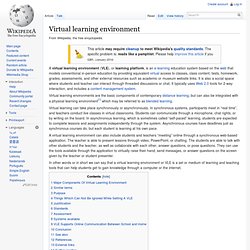

www.aishe.org/readings/2005-1/donnelly-fitzmaurice-Designing_Modules_for_Learning.pdf. Educating the Net Generation. The Net Generation has grown up with information technology.

The aptitudes, attitudes, expectations, and learning styles of Net Gen students reflect the environment in which they were raised—one that is decidedly different from that which existed when faculty and administrators were growing up. This collection explores the Net Gen and the implications for institutions in areas such as teaching, service, learning space design, faculty development, and curriculum.
Contributions by educators and students are included. The printed book is available through Amazon.com. Diana G. Virtual learning environment. A virtual learning environment (VLE), or learning platform, is an e-learning education system based on the web that models conventional in-person education by providing equivalent virtual access to classes, class content, tests, homework, grades, assessments, and other external resources such as academic or museum website links.

It is also a social space where students and teacher can interact through threaded discussions or chat. It typically uses Web 2.0 tools for 2-way interaction, and includes a content management system. Virtual learning environments are the basic components of contemporary distance learning, but can also be integrated with a physical learning environment[1] which may be referred to as blended learning. Virtual learning can take place synchronously or asynchronously.
Characteristics.